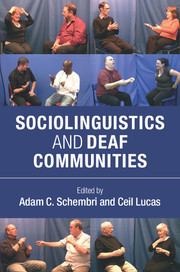Book contents
- Frontmatter
- Contents
- List of Figures
- List of Tables
- Notes on Contributors
- 1 Introduction
- 2 Sign languages in the world
- 3 Sign languages in contact
- 4 Variation and change in sign languages
- 5 Discourse analysis and sign languages
- 6 Language policy and planning in Deaf communities
- 7 Language attitudes in Deaf communities
- Index
- References
7 - Language attitudes in Deaf communities
Published online by Cambridge University Press: 05 February 2015
- Frontmatter
- Contents
- List of Figures
- List of Tables
- Notes on Contributors
- 1 Introduction
- 2 Sign languages in the world
- 3 Sign languages in contact
- 4 Variation and change in sign languages
- 5 Discourse analysis and sign languages
- 6 Language policy and planning in Deaf communities
- 7 Language attitudes in Deaf communities
- Index
- References
Summary
Introduction
In May 2011, a major controversy erupted in Italy regarding the official recognition of the sign language used by Italian Deaf people (see Nassisi 2010; La protesta 2011; LIS Subito! n.d.; Searls 2011). Since the 1980s, this sign language has been recognized in the Italian Deaf community as Lingua dei Segni Italiana (conventionally abbreviated as LIS, not LSI, which would follow the conventions of spoken and written Italian) which is translated as Italian Sign Language, but the name of the language is not widely known among hearing people in Italy. Leaders of the Italian Deaf community had been working to achieve the official recognition of LIS to affirm its language status and its essential role in supporting for Deaf people's access to information in education, employment, and service. The leaders were close to getting official recognition when one house of the Italian Parliament, the Senate of the Republic, approved the bill in recognizing LIS and it only needed approval from the other house of the Italian Parliament, the Chamber of Deputies, in order to pass the bill (La protesta 2011). In May 2011, the Chamber of Deputies revealed a change in the bill in calling what they thought was a more accurate name for the sign language: Linguaggio Mimico-Gestuale (LMG) (Searls 2011). The English translation of the name is “language of mime and gesture” with the meaning of language as a particular communication activity (e.g., baby talk or technical jargon) rather than a full-fledged linguistic system. The former name had reflected and affirmed the linguistic status of the sign language, but the new name was an implicit rejection of that status. The Parliament was willing to pass the bill with the new name, but the Deaf community refused to accept the name and called for keeping the former name which reflected the actual nature of LIS (LIS Subito! n.d.). Despite the intervention by the leaders of the Italian Deaf community and academics and researchers in LIS- and Deaf-related fields, the call for retaining the former name went unheard; instead, the Parliament drafted a new bill with the support of medical professionals that required speech and hearing interventions for deaf children, including the use of cochlear implants, in order to ensure proper educational and language developments for them (LIS Subito! n.d.).
- Type
- Chapter
- Information
- Sociolinguistics and Deaf Communities , pp. 146 - 174Publisher: Cambridge University PressPrint publication year: 2015
References
- 2
- Cited by



